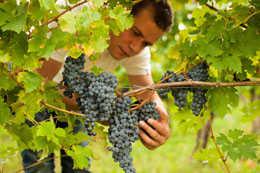Pruning grapevines is a difficult as well as confusing task for most garden lovers. This article provides some information about this practice and some tips which might prove beneficial for doing the same.

Planting the grapevines in the backyard is one of the oldest traditions. This plantation would give the gardeners a delicious and fresh taste of the homegrown grapes. And for that, pruning the grapevines is a must. It is also necessary to maintain the shape and the size of the vines and productivity of the grapes. Furthermore, it avoids the messy and tangled shape of the grapevines and helps the fruits to ripen fully.
Need for this Practice
There are many reasons for grapevine pruning and so are the precautions that need to be taken. This practice in the winter season is the best thing that one can do to ensure the health of one's grapevines. Winter is the dormant season for many of the trees hence, it is the best time to prune them. This practice is always advisable after leaf fall of the grapevines, which is after late fall and throughout the winter. During the period before fall, important minerals and carbohydrates are transferred to the woody part of the vine for the winter storage. Whereas in fall season, it can cause irreversible damage to the health of the vine. After the leaf fall, the vascular system of the plant plugs up and hence it is the best period for the process.
- Grapevines are called woody tree climbers that climb by attaching themselves with the help of their tendrils. In any case, the maintenance of the shape of the vine is an important thing to be observed.
- Bud selection and bud placements are the two things that are done during the process which actually improve the bud fruitfulness. Hence, pruning during the growing season can be called an investment for the buds of next season.
- Furthermore, it maintains the shoot number of the grapevines. Removing unwanted new shoots and regulating total number of shoots is one of them.
- Improving the quality as well as the quantity of the fruits is one of the prime motives of this process. Fruit-bearing capacity of the grapevines depend on the photosynthetic activity and the number of the leaves.
All in all, grapevine pruning is an important task that a gardener must learn to perform. Pruning the vines in the first year of plantation is not a great idea. Not doing so in the first year would ensure the development and strength of the root system.
Some Tips
- One would have to select the strongest looking stem of the vine to start the procedure. Then, by using a pair of bypass scissors remove all the nearby stems at the base of the plant and as close to the trunk of the selected stem as possible. Stake the remaining of the stem (that will serve as the trunk of the plant) and secure it with a wire or with the grape stake.
- Allow stems of the vine to grow only from the main trunk and in the spring of the second year, remove all the stems excluding two of the best looking side shoots that are growing from the trunk. Further, one can also encourage side branching by pinching the top of the main trunk.
- Again, start the procedure in summer or mid summer of the second year. This time, cut back the top of the main trunk just at the time when the vine has reached the desired height. This process is called tip pruning and allows the growth of new and healthy leaves along the main trunk.
- Cut all the unwanted side branches during the second winter season, so that one can have the basic frame of the plant which is an upright trunk with two outward side stems.
This process is easy when done with selective garden tools and the knowledge of gardening. Now that one is aware of the procedure, one can add charm to the grapesvines in one's garden.






 Planting the grapevines in the backyard is one of the oldest traditions. This plantation would give the gardeners a delicious and fresh taste of the homegrown grapes. And for that, pruning the grapevines is a must. It is also necessary to maintain the shape and the size of the vines and productivity of the grapes. Furthermore, it avoids the messy and tangled shape of the grapevines and helps the fruits to ripen fully.
Planting the grapevines in the backyard is one of the oldest traditions. This plantation would give the gardeners a delicious and fresh taste of the homegrown grapes. And for that, pruning the grapevines is a must. It is also necessary to maintain the shape and the size of the vines and productivity of the grapes. Furthermore, it avoids the messy and tangled shape of the grapevines and helps the fruits to ripen fully.